NYC F-7A #1785 with sister unit, leading Northbound train of tank cars at the south switch to the siding and yard in Nitro on a warm July evening in 1967
Nitro, a town situated on the Kanawha River approximately 15 miles west of the capital city of Charleston, came about as a result of World War I. It was established by the Federal Government in 1918 to produce Nitro-Cellulose, a type of gunpowder. Approximately 1217 acres of land was acquired by the government in December, 1917. Because of the enormous size of the of the explosive plant, it was necessary to bring in thousands and thousands of workers to build the plant and also construct housing for the workers who built the plant and those who worked in the plant itself.
Eleven months later the war ended and the need for the explosive plant ended. By his time the town of Nitro was nearly 90% complete. The population was nearly 24,000. Nitro at that time had the latest design for housing and utilities, plus it had its own school system and full time police and fire protection. A more detailed history of how Nitro came into existence can be found on the city’s website www.cityofnitrowv.com.
After the war, the city of Nitro was established in 1921 and the site used for manufacturing munitions had become attractive to a number of chemical companies. By the time my dad graduated from Marshall College (now University) in 1950 with a degree in chemical engineering, the town could boast of companies like American Viscose, Monsanto, FMC, Ohio Apex and General Chemical being located there. The latter company was the one my dad began working for. I was two years old at the time we moved from my grandparents home in Huntington to a rental house on 9th Street in Nitro. A few years later my mom and dad bought property on North 21st Street and built a house which I lived in during my elementary and high school years.
Besides the rich history of the formation of Nitro, the rail line through the city has a history as well. The Kanawha and Ohio which later became the Kanawha and Michigan Railroad, due to reorganization, was built from Point Pleasant, WV and completed to Charleston some time around 1890. During that time the K&M purchased the Charleston and Gauley which gave the K&M a connection with the Chesapeake and Ohio in the Gauley Bridge area plus enabled it to tap into the coal fields north of Gauley Bridge.
In 1910 the C&O gained control of the K&M hoping to get access to the Great Lakes but anti-trust laws forced the C&O to give up the K&M. The C&O sold its K&M shares to the Toledo and Ohio Central in 1914. In 1922 the T&OC with its interests in the K&M was leased to the New York Central Railroad. In 1938 the K&M was officially merged into the T&OC and in 1952 the T&OC was merged into the NYC. For all practical purposes it was an NYC operation from 1922. A recently published book entitled “The Kanawha and Michigan Railroad” by Don Mills documents the history of this line.
The line through Nitro was operated as part of NYC’s Kanawha Secondary. The line was single track with yards and passing sidings that were located for the most part in the yards. Besides Nitro, yards were located in Institute, Charleston and Dickinson. Smaller yards were located at Belle, Alloy and Gauley Bridge. Maximum speed on the Secondary was not much more than 25 or 30 MPH. Besides coal and merchandise freight, the line handled a good bit of chemical business.
In addition to the plants in Nitro mentioned earlier, the NYC also served the Union Carbide and Goodrich-Gulf plants in Institute, Union Carbide’s North Charleston facility, DuPont’s Belle operation and Union Carbide Metals plant at Alloy. Also the coal mine at Cannelton and Appalachian Power plant near Cedar Grove was served by the NYC.
The NYC merged with the Pennsylvania Railroad on February 1, 1968 to form the ill-fated Penn Central Transportation Company. Two years later Penn Central went bankrupt. On April 1, 1976, Penn Central became part of Conrail which brought together the PC and six other bankrupt railroads in the northeast. Then on June 1, 1999, as part of the Conrail breakup between CSX Corp. and Norfolk Southern Corp., the West Virginia Secondary, which included the old Kanawha Secondary, became part of Norfolk Southern Railway. Originally it was placed in NS’s Dearborn Division but approximately a year later it was transferred to the Pocahontas Division with the exception of the first seven miles out of the yard in Columbus, OH which went to the Lake Division. Incidentally I retired from NS on November 1, 2003.
I began photographing around Nitro in 1966, the year I graduated from high school. By that time I was old enough to drive on my own plus I was aware of the impending merger with the PRR and wanted to document NYC’s operations not only in Nitro but other areas in the Kanawha Valley. The Nitro yard had a full time switch engine to work the yard including leads to the chemical plants. The old Nitro depot which was a fixture in the city since its inception was torn down in 1967 and replaced by a new building located across the yard from the Nitro business district. First Avenue which was the main thoroughfare in Nitro and paralleled the Secondary, curved around the old depot. A few years after it was torn down First Avenue was straightened.
I hope this brief glimpse of Nitro has given you a taste of its history and the railroad(s) that served it, and still do to this day.
Two Views of Nitro Depot. On left is looking North and on right look south toward Charleston. Both photos were taken in July, 1966.
Approximate same views as above after the old depot was torn down. This was taken in July, 1967. In picture on the left you can see smoke stacks of the chemical plants in the distance and the new yard office building. Also where I was standing, First Avenue was realigned and now runs through this spot.
NYC SW-9 8999 sitting at the old depot between assignments. You can see part of the old ESSO gas station in the photo on the left and downtown Nitro in the right photo. If you look close enough you can see the posted price of regular gasoline which was 31.9 cents/gallon.Both photos were taken in July, 1967.
Two southbounds at different times in 1967. The photo on the left was taken in July 1967 . You can see a mixture of locomotives in this train. Photo on the right was taken on a crisp clear day in March with classic F-7 units coupled back to back. Train was switching in the yard before heading toward Charleston.
Northbound leaving Nitro headed to Point Pleasant. Evidence of the Penn Central merger is real with SD-40 6075 in the lead with ex-NYC bay window caboose bringing up the rear. Six axle units were uncommon on the Secondary until after the merger. Photo was taken in November, 1970.
Closeup of NYC yard office taken in July, 1967. Compare photo on left with that on right taken in May, 2003 nearly 4 years after the breakup of Conrail. They are at different angles but you can see the change in the exterior of the building and also the old brick smokestack left from the days of the munition plant is gone. Unit is ex-Southern Railway GP38-2.
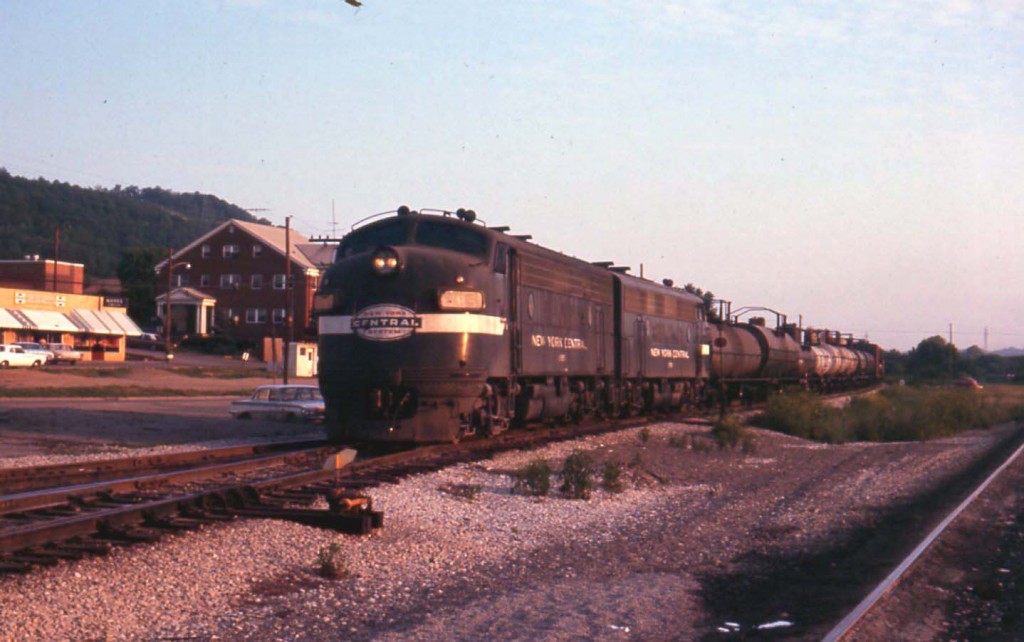
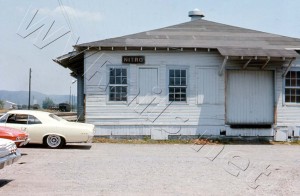
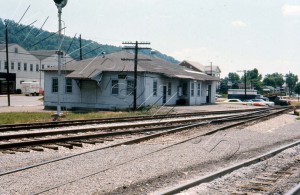
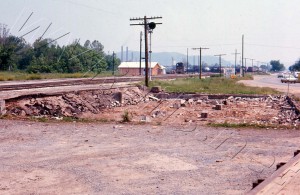
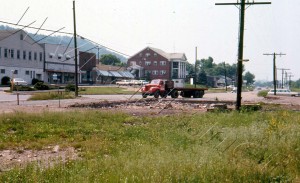
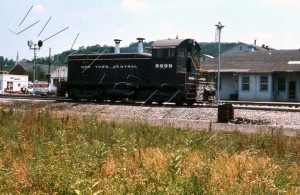
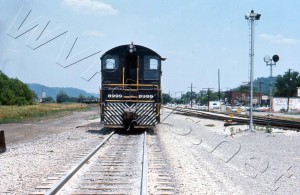
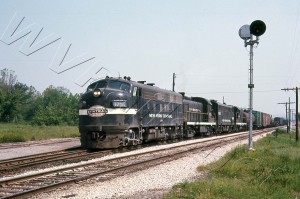
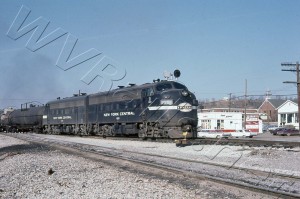

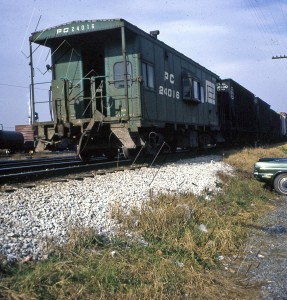
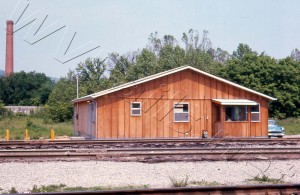
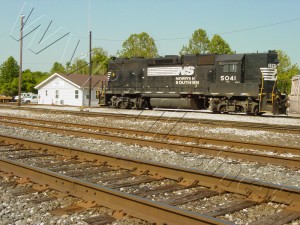
Recent Comments